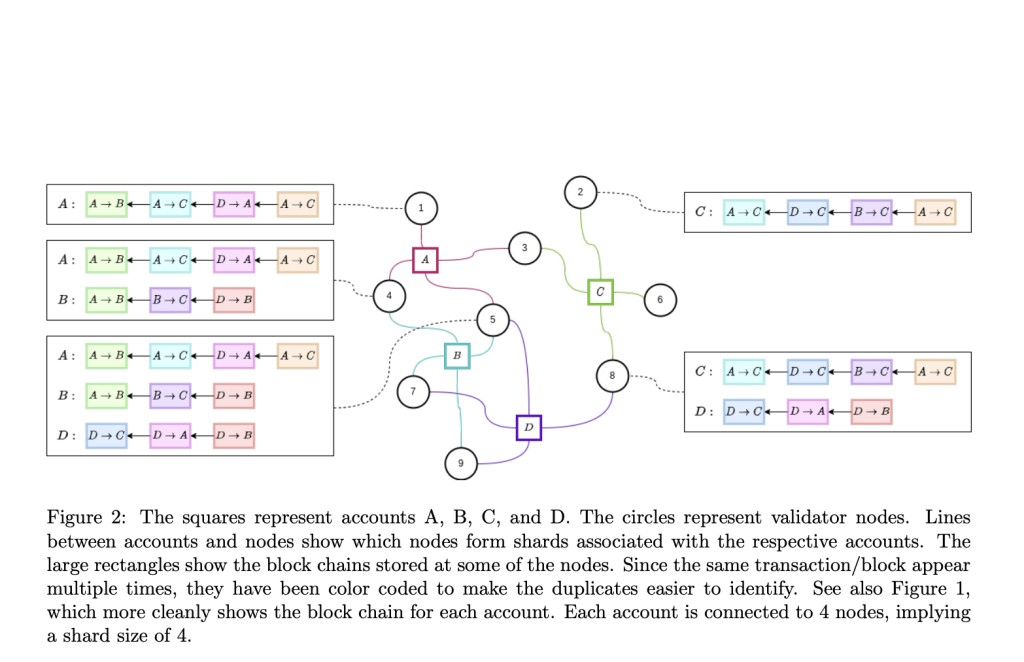DLT, such as blockchain, is crucial for managing numerous micro-transactions in the Machine Economy, which involves billions of interconnected and decentralized devices. To enhance DLT scalability, sharding is often used, dividing the network into multiple committees. However, this requires costly cross-shard verification to prevent double-spending, complicating scalability. Solutions to improve DLT scalability include first-layer approaches like sharding and bigger blocks and second-layer approaches like parallel side chains. Despite the challenges, lessons can be learned from Distributed Hash Tables (DHT), which manage dynamic sharding without consensus or ordered history.
Researchers at Luleå University of Technology propose ScaleGraph, a scalable distributed ledger method that uses dynamic sharding based on routing and logical proximity concepts from distributed hash tables. ScaleGraph enhances cybersecurity and supports frequent micro-transactions between autonomous devices. Each transaction is logically processed and stored by nodes close to the sender and receiver, enabling direct cross-shard verification and forming a partially ordered DAG for concurrency. ScaleGraph’s storage complexity is O(t), sharded over n nodes, with each node needing O(t/n) storage. This method improves concurrency and data localization, offering better scalability and performance than consensus models.
Blockchain technology has reignited interest in Byzantine-fault tolerant (BFT) consensus protocols. While synchronous systems assume timely message delivery and synchronized clocks, asynchronous systems, more realistic for real-world networks, face the FLP impossibility, making deterministic consensus unachievable if any node fails. Partially asynchronous solutions like PBFT rely on synchrony for liveness. Asynchronous protocols like HoneyBadgerBFT offer resilience up to one-third of Byzantine nodes but have higher latency. Synchronous protocols, like Sync HotStuff, achieve better fault tolerance (up to half Byzantine nodes) and improved performance, which is essential for sharding solutions that balance shard size for security and performance.
In ScaleGraph, a node can simultaneously act as a leader for multiple sender accounts without issues, as they involve separate chains. However, if two nodes briefly lead to the same sender address, the new leader’s proposals are addressed once the ongoing consensus is completed. To avoid deadlock in high-contention scenarios where multiple transactions involve the same receiver, ScaleGraph can implement locking to prevent resource wastage from retries. In rare deadlock cases involving cyclic transactions, resolutions include timeouts with randomized back-off or a proactive approach that locks based on address size. However, the latter may preferentially treat smaller IDs, which may lead to starvation.
Blockchains ensure data integrity with immutable ledgers, preventing history rewriting. However, sharding, which enhances performance by dividing nodes into smaller groups, compromises security by making it easier for attackers to control these smaller groups. In ScaleGraph, overlapping shards mitigate this risk somewhat but still pose challenges. To prevent double spending and ensure fault tolerance, rigorous vote counting, and periodic shard rebuilding are crucial. Sharding also reduces data redundancy, affecting availability. Simulations show that shard size impacts the probability of compromise, with larger, more numerous shards increasing failure probability, though this effect is relatively modest.
In conclusion, ScaleGraph is a scalable DLT using dynamic sharding and DHTs to support frequent micro-transactions between devices. Unlike typical methods, ScaleGraph allows overlapping shards for increased parallelism. Simulations show that a synchronous consensus protocol significantly reduces shard size requirements compared to asynchronous ones, enhancing performance and security. The system requires only a partial order of transactions, optimizing parallelism. Future work includes a formal security analysis, more accurate failure probability modeling, and performance evaluation to balance the trade-off between shard size and system efficiency.
Check out the Paper. All credit for this research goes to the researchers of this project. Also, don’t forget to follow us on Twitter. Join our Telegram Channel, Discord Channel, and LinkedIn Group.
If you like our work, you will love our newsletter..
Don’t Forget to join our 43k+ ML SubReddit | Also, check out our AI Events Platform
The post ScaleGraph: Enhancing Distributed Ledger Technology DLT Scalability with Dynamic Sharding and Synchronous Consensus appeared first on MarkTechPost.
Source: Read MoreÂ

